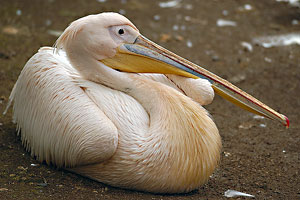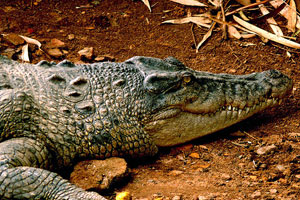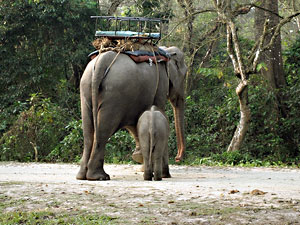|
|
Wildlife Sanctuaries in East India |
|
Assam Wildlife
Sanctuaries |
|
Nameri National Park
Nameri National Park is situated at the foot hills of
eastern Himalayas, about 35 km. from Tezpur. Nameri
National Park covers an area of about 200 square km.
Hills, deciduous forests and the river Jia Bhoroli have
all added a unique charm to it. It is situated in the
eastern border of Assam in the valley and mountainous
Arunachal Pradesh. Jia Bhoroli river of Assam is famous
for the Mahseer angling, since the time of British. This
perennial river |
 |
|
|
enters Assam
in the plains, near Bhalukpung after swirling through the
rugged mountains of Arunachal. Its is home of the Golden
Mahseer - The Tiger of Indian rivers and a catch for any
angler. Many wildlife animals are found here like the Tiger,
Elephant, Leopard, Indian Bison, Sloth Bear, Sambar, Gaur,
Himalayan Black Bear, Pangolin, Indian Wild Dog, Civet Cat,
Capped Langur etc. The other reason Nameri is famous for is
the herds of elephants. The park have a high density of
elephant population and due to lessening of forest cover, they
sometimes invade human inhabited villages, which have
attracted the attention of wildlife conservationists
worldwide. Nameri is a heaven for bird watchers which include
the most endangered White Winged Wood duck, four species of
Hornbill and small and beautiful Scarlet Minivet. Various
species of reptiles, butterflies and moths are also found in
this National Park. Atlas Moth with a wing span of more than
10 inches has also been spotted here. The best season to visit
this park is from October to April.
Dibru-Saikhowa National Park
The Dibru-Saikhowa National Park is the fourth National Park
of Assam, that lies partly in Dibrugarh district and partly in
Tinsukia district. This national park is about 13 kms from
Tinsukia Town, which is 483 kms from Guwahati. This national
park covers an area of about 340 square kms. Of the seven
parts of the park one part is wet land and the rest is mainly
grassland and dense forest. The main attractions of this park
are its semi-wild horse and White winged Wood Duck. Besides
this, other animals like Leopard, Clouded Leopard, Elephant,
Sambar, Slow Loris, Indian wild water Buffalo, Capped Langur,
Gangetic River Dolphin, Indian Wild Dog can be seen in this
park. More than 250 varieties of local and migratory birds are
also found in this park. The best season to visit this park is
from November to March.
Orang National Park
Orang National Park is also known as a mini Kaziranga National
Park and covers an area of 78.81 square kms. The Orang
National Park is situated on the north banks of river
Brahmaputra in the Darrang District of Assam, about 150 kms
from Guwahati and 31 kms from Tezpur. Sixty percent of the
park is covered by grassland. The animals that can be seen in
the Orang National Park are the One-horned Rhinoceros,
Pangolin, Hog Deer, Civet cat, Otters, Wild Boar, Leopard,
Elephant, Sambar, Barking Deer and Tiger. Besides the animals,
varieties of water birds, Green Pigeon, Florican, Teal, Goose,
Pelican, Cormorant, Greylag Goose, Large Whistling Tea Great
Adjutant Stork, Kingfisher, Vulture etc. can also be seen in
this park.
Pobitora Wildlife Sanctuary
Pobitora Wildlife Sanctuary is situated in the Morigaon
district of Assam, about 60 kms from Guwahati. Pobitora is one
of the major wildlife sanctuaries of Assam. This wildlife
sanctuary covers an area of 38.8 square km. Pobitora is mainly
famous for its Great Indian One-horned Rhinoceros. Other
animals such as the Asiatic Buffalo, Leopard, Wild Bear, Civet
Cat etc. are also found here. More than 200 birds and various
reptiles are found in this sanctuary. The best season to visit
this sanctuary is from November to March. |
|
|
|
Meghalaya Wildlife Sanctuaries |
|
Balpakram National Park
Balpakram is a fertile virgin land. The unsurveyed belts
of limestone and coal deposits, along with sea shells
fossilized into rocks in Balpakram Hill provide immense
scope for geological and archeological studies. The
animals which can be seen in this national park are
Elephant, Wild buffalo, Gaur (Indian bison), Sambar,
Barking deer, Wild boar, Slow loris, Capped langur,
Tiger, Leopard, Clouded leopard and the Rare Golden cat.
|
 |
|
|
|
|
Mizoram Wildlife
Sanctuaries |
|
Ngengpui Wildlife Sanctuary
The Ngengpui Wildlife Sanctuary is situated in the Lawngtlai
District in the south-western part of Mizoram. It is located
very close to the Indo-Myanmar and Indo-Bangladesh border. The
sanctuary covers a total area of 110 square km. and ranges in
altitude from 200 m to about 1200 m above sea level. The wild
animals found in this Sanctuary are Tiger, Clouded leopard,
Elephant, Guar, Barking deer, Sambar, Wild boar, Hoolock
Gibbon, Rhesus macaque, Leaf monkey, Common langur, etc.
Lengteng Wildlife Sanctuary
The Lengteng Wildlife Sanctuary is situated in the eastern
part of Mizoram adjacent to Murlen National Park. The
sanctuary covers an approximate area of 80 square km and
ranges in altitude from 400 m to about 2300 m. The second
highest Peak in Mizoram can also be seen in this park. Some of
the wild animals and birds found in this sanctuary are Tiger,
Leopard, Sambar, Barking deer, Wild boar, Hoolock gibbon,
Rhesus macaque, Ghoral, Serrow, Hume's Bartailed Pheasant,
Kaleej Pheasant.
Thorangtlang Wildlife Sanctuary
The Thorangtlang Wildlife Sanctuary is situated about 240 km
from Aizawl in the Western Part of Mizoram and very close to
Dampa sanctuary. The sanctuary also acts as a corridor for
elephants which migrate from Bangladesh. The area of this
sanctuary is 50 square Km. Tiger, Leopard, Hoolock gibbon,
Leaf Monkey, Sambar, Barking Deer and variety of birds can be
seen in this sanctuary.
Phawngpui National Park
The Phawngpui National Park is situated in South Eastern
Mizoram close to the Myanmar border. The highest peak in
Mizoram, the Phawngpui (2360 m) is located within this park.
The park covers a total area of 50 square km. Some of the
animals and birds found in this park are Ghoral, Serrow,
Barking deer, Sambar, Leopard, Blyth's tragopan, Kaelej
Pheasant, Hoolock Gibbon, Common Langur, Rhesus macaque, Stump
tail macaque and variety of birds and orchids.
Murlen National Park
The Murlen National Park is situated about 245 km east of
Aizawl and close to the Myanmar border. This national park is
located close to the Chin Hills. It covers an area of 150
square km and ranges in altitude from 400 m to about 1900 m.
Tiger, Leopard, Himalayan black bear, Hoolock gibbon, Sambar,
Barking deer, Ghoral, Serrow, Rhesus macaque, Wild boar,
Pheasant and many varieties of birds and orchids can be seen
in this park. There are five villages around the park and one
village namely Murlen village with seventy families are
residing inside the park.
Palak Wildlife Sanctuary
Palak Wildlife sanctuary lies in the in Saiha District in the
southern part of Mizoram. The sanctuary covers an area of
around 15.5 square km. Elephant, wild boar and varieties of
birds found in this sanctuary. Palak Dil, a natural lake is
located within the sanctuary. The Palak Lake area is popularly
known as the heaven on earth not only for its natural beauty
but also because it is home to a wide range of beautiful
butterflies and moths.
Dampa Wildlife Sanctuary
Dampa Wildlife Sanctuary is located at the tri-junction of
Bangladesh, Tripura and Mizoram. Dampa Wildlife Sanctuary is
the oldest and the largest wildlife sanctuary in Mizoram. This
wildlife sanctuary is situated in the Mamit District in the
western part of Mizoram, about 127 km from Aizawl. This
wildlife sanctuary sprawls over an area of 650 square kms. and
established in 1976. The virgin forests of Dampa Tlang and
Chhawrpial Tlang are the unique natural features of the
sanctuary. It is the home of eastern Himalayan wild animals
like tiger, wild dog, giant squirrel, porcupine, slow loris,
leopard, elephant, gaur (Indian Bison), sambar, swamp deer,
barking deer, sloth bear, wild pig, hoolock gibbon, leaf
monkey, langur, rhesus macaque, jungle cat, wild boars and
wide variety of butterflies, birds and flowers. There are 10
villages around the sanctuary with a population of roughly
10,000 tribes like Mizo, Chakma, and Riang (Tuikuk). |
|
|
|
Orissa Wildlife Sanctuaries |
|
Nandankanan Wildlife Sanctuary
Nandankanan Wildlife Sanctuary is situated amidst lush
green forest along the banks of Kanjia lake, about 20
kms. from Bhubaneshwar. This wildlife sanctuary is set
in a beautiful natural setting and one of the finest
parks with natural enclosures. The park has an open Lion
Safari and first zoo in the world, where gharials and
black panthers are bred in captivity. This wildlife
sanctuary is also known for the white tigers. Leopards,
rhinoceros, |
 |
|
|
elephants,
bear, monkey and several other types of mammals can also be
seen at close quarters in the natural surroundings. It boasts
of a beautiful botanical garden too. Other tourist attractions
in the park include nocturnal animal house, toy train ride,
rope-way ride across a natural lake and boating in the lake.
Simlipal National Park
Simlipal National Park is the main national park located in
the Mayurbhanj district in Orissa. This park has dense green
forests, hilly terrain, broad open valleys, plateaus,
grasslands, sal trees, waterfalls, gorges and rich
bio-diversity. It extends over an area of 2750 square km at
the heart of which is one of the India's earliest tiger
reserves covering about 300 square km. The topography consists
of semi-evergreen to dry deciduous forests, including 1076
species of plants and 94 varieties of orchids. About 42
species of mammals, 231 species of birds and 29 species of
reptiles make this place their habitat. The wildlife in this
park include tiger, elephant, leopard, wolf, chital, sambar,
spotted deer, barking deer, mouse deer, gaur, flying squirrel
and variety of birds like hill myna, parakeets, hornbills,
peacock, etc. Simlipal is the richest watershed in Orissa and
feed several perennial rivers like Budhabalanga, Khadkei,
Khairi-Bhandan, Westdeo, Salandi etc. Simlipal is a unique and
delightful destination for scientists, nature lovers, students
and tourists.
Satkosia Gorge Wildlife Sanctuary
Satkosia Gorge Wildlife Sanctuary is unique in geomorphology
in India. Here Mahanadi has out right across the Eastern Ghats
and has formed a magnificent gorge. Satkosia Gorge Wildlife
Sanctuary is located in the districts of Angul, Cuttack,
Nayagarh and Boudh and is an attractive place for scientist
and nature lovers. Satkosia gorge wildlife sanctuary covers an
area of 796 square km. and has sylvan beauty and excellent
natural features. The major attraction of the area is 22 km.
long gorge, known as Satkosia gorge which divides the area
into two distinct parts. The area supports moist deciduous
forest, dry deciduous forests and moist peninsular sal
forests. Tiger, leopard, elephant, gaur, sambar, spotted deer,
mouse deer, nilgai, chousingha, sloth bear, wild dog,
varieties of resident and migratory birds and reptiles
including gharial, mugger crocodile, fresh water turtle,
poisonous and non-poisonous snakes can be seen in the
sanctuary.
Bhitarkanika Wildlife Sanctuary
Bhitarkanika Wildlife Sanctuary is located in the Kendrapada
district. Bhitarkanika is surrounded by rivers such as
Brahmani, Baitarani and Dhamara and criss-crossed by several
creeks and creeklets. The area supports rich bio-diversity
including 63 species of dense mangroves, estuarine crocodiles,
the rare white crocodile, largest Indian lizards, poisonous
and non-poisonous snakes like king cobra and python, 217
varieties of resident and migratory birds and various mammals
including spotted deer, sambar, wild boar, fishing cat, jungle
cat, otter etc. The sea beach, borderding the sanctuary
attracts thousands of olive ridley sea turtles for mass
nesting during the winter months. Bhitarkanika mangrove
ecosystem is unique of its kind and a best reptile refuge in
the entire country.
Badarama Wildlife Sanctuary
Ushakothi, also known as the Badarama Wildlife sanctuary is
located in the Sambalpur district, about 48 km. from Sambalpur
on the NH-6 under Bamra Forest Division. This wildlife
sanctuary covers an area of 130 square km. Its prime location
in western Orissa with hilly undulating areas and rich dry
deciduous mixed forests provides a habitat to wide variety of
fauna including tiger, leopard, wild elephant, hyena, wild
boar, panther, spotted deer, bison, sambar, bear, porcupine
and a number of birds and reptiles. The best time to visit the
sanctuary is in the night between 2000 and 0200 from November
to June, accompanied by a guide. The animals can be best
viewed from the watch towers sited near the watering points
where the animals came to drink water.
Sunabeda Wildlife Sanctuary
Sunabeda Wildlife Sanctuary is located close to the boundary
of Chhatisgarh state on the western fringe of Orissa in the
newly created Nuapada district. This sanctuary covers an area
of 600 square km. of dry deciduous forests. The plateau on the
hill top holds a slightly undulating flat land with good
edible grass. Eleven beautiful waterfalls and seasonal streams
which dry out during summer leaves few deep pools of water.
This sanctuary is considered as an ideal habitat for
Barasingha. The other major wildlife species are tiger,
leopard, hyena, barking deer, chital, gaur, sambar, sloth
bear, varieties of birds such as hill myna, pea fowl,
partridge and reptiles.
Chandka Dampara Wildlife Sanctuary
Chandka Dampara Wildlife Sanctuary is situated 20 kms. from
the centre of temple city of Bhubaneswar. Chandka Dampara
Wildlife Sanctuary covers an area of 176 square km. This small
and attractive sanctuary with undulating topography presents a
rich bio-diversity. The mixed tropical dry decidous and moist
deciduous forests including bamboo and planted teak provide
ideal habitat for elephant, leopard, hyena, spotted deer, wild
dog, wild boar, ratel, pangolin, pea fowl, red jungle fowl,
white ibis, dab chicks, open bill stork, egret, python,
monitor lizard etc. The natural water body and forests
provides nesting ground for 82 species of migratory and
resident birds. |
|
|
|
West Bengal Wildlife Sanctuaries |
|
Jaldapara Wildlife Sanctuary
The Jaldapara Wildlife Sanctuary is situated in
Alipurduar sub-division of Jalpaiguri district in West
Bengal and about 124 kms. from Siliguri. This wildlife
sanctuary is spread over an area of 114 square km. and
located close to Phuntsholing in Bhutan. The nine
tributaries of the Torsa river flow through the area
which is shaded by tall grasses, mighty trees, perennial
streams and sandy riverbanks. This sanctuary was
established in the year 1941 for the protection of
one-horned rhinos. The one–horned rhino, tiger,
|
 |
|
|
including the
Royal Bengal Tiger, Wild elephant, Deer, Bear, Sambar, Barking
deer, Hog deer, Leopard, Wild pig, Bison and various other
birds can also be seen here. Elephant safaris can be enjoyed
in the Sanctuary. The best time to visit the sanctuary is
between October and May. The nearest airport is situated at
Bagdogra. Jaldapara is connected by road with Darjeeling and
Siliguri. The Madarihat is the nearest railway station which
is only 7 kms from the Sanctuary.
Sunderbans National Park
The Sunderbans National Park lies south of Kolkata, where the
Ganga with its various tributaries form the largest delta of
the world. Piyali, 70 kms from Calcutta via Dosarhat is the
gateway to the Sunderbans. Sunderbans means the beautiful
forests and derives its name from the words Sundari and ban,
which means "the forests of sundari" or mangrove trees.
Sunderbans is mainly covered by mangrove forests and vast
saline mud flats and covers an area over 2500 square km in the
Ganga-Brahmaputra delta and spread across to Bangladesh. The
Sunderbans was declared as a World Heritage Site by UNESCO in
1997. The Sunderbans are the largest estuarine forests in the
world. It is a land of 54 tiny islands, crisscrossed by
various tributaries of Ganga, that was once infested by
Arakanese and Portuguese pirates and is now, the abode of
varied flora and fauna. This tiger and biosphere reserve still
preserves the natural habitat of 200 or more Royal Bengal
Tigers. Besides Tiger, Spotted deer, Jungle Cat, Fishing cat,
Indian fox, Mongoose, Spotted deer, Wild pig, Indian flying
fox, Wild boar, Small Indian civet, Gangetic dolphin, Rhesus
monkey, Snake, Pangolin, Sea turtle, Cobra, Python and
Crocodiles are the other wildlife which can be seen here.
Sunderbans is also the breeding ground of immense variety of
birds like Heron, Egret, Cormorant, Fishing Eagle, White
Bellied Sea Eagle, Seagul, Tern, Kingfisher, Whimprel,
Black-tailed Godwit, Little Stint, Eastern Knot, Curlew,
Sandpiper, Golden Plover, Pintail, White-eyed Pochard and
Whistling teal. The Sunderbans are accessible only by
waterways. Motor launch facilities are available round the
year. The ideal time to visit the Sunderbans is during the
months of August to March.
Padmaja Naidu Himalayan Zoological Park
Padmaja Naidu Himalayan Zoological Park is the famous
zoological park in Darjeeling. This park is located adjacent
to the Himalayan Mountaineering Institute and is a
high-altitude wildlife park. This Zoological Park is the home
of the Siberian tiger, Himalayan black bear, Deer, Panda,
Panther, Snow leopard, Llama and many colourful birds. |
|